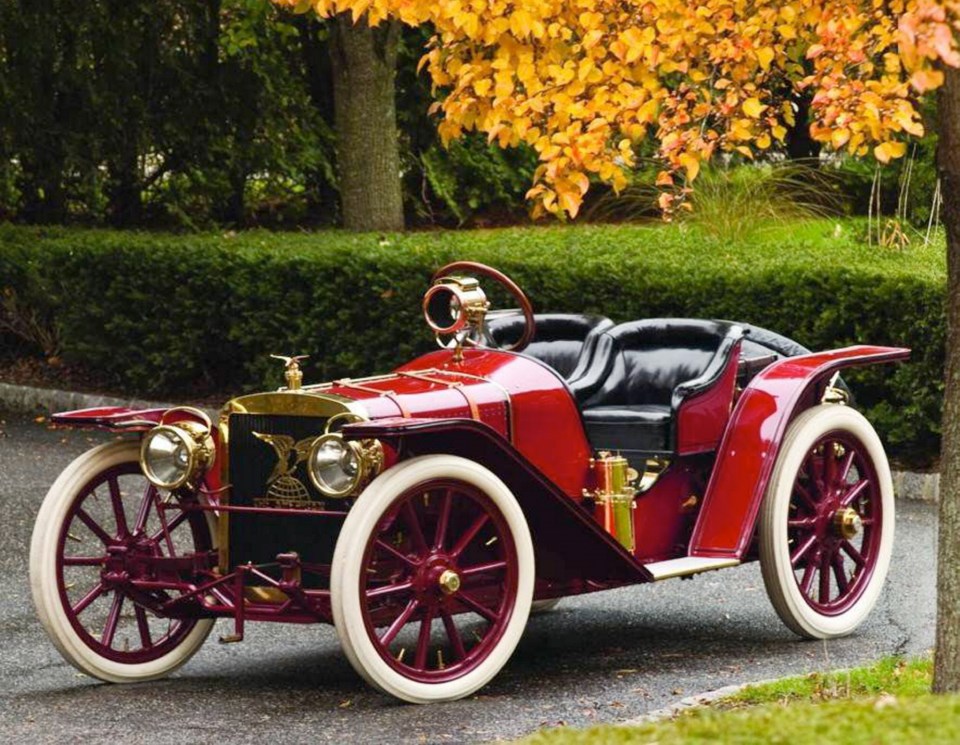When cars first appeared, most of them had evolved from buggies and carriages. They rode on tall, wood-spoked wheels and had wooden bodies and rudimentary suspensions. It didn’t take long for them to start taking on their own persona.
The first decade of the 20th century brought improved roads, allowing smaller wheels and lower cars. Some companies took the lowering trend further than others, and the one that went the furthest was the American Motor Car Co., established in Indianapolis, Indiana, in 1906.
American showed its first cars, a conventionally suspended Touring and an “underslung” Roadster, in 1906 as 1907 models. Although the company produced both conventional and underslungs, the underslung design would be its lasting legacy.
The underslung creation was widely credited to Harry C. Stutz, a practical engineer who later established a famous company producing cars bearing his own name. But although Stutz designed the conventional chassis Touring model for American Motor Car Co., and was with the company when the underslung Roadster was conceived, the Roadster’s father seems to have really been American’s chief engineer, Fred I. Tone.
To make the car as low as possible, Tone in effect turned the conventional chassis upside down. Instead of placing the frame above the axles as other engineers did, he put the frame below the axles with the semi-elliptic leaf springs mounted above it.
This produced a car that was rakishly low for its day. To preserve ground clearance, he used huge 40-inch wheels and the engine was mounted on its own raised subframe.
When the first dashing underslung Roadster arrived late in 1906, its front fenders were about level with the top of the hood. The company extolled the underslung’s safety virtues by emphasizing its stability and resistance to rollovers.
With a centre of gravity just above axle height, sales literature claimed the car could be tilted over 55 degrees without rolling over. This compared with about 45 degrees for conventionally suspended models, an impressive feature.
The underslung was powered by a huge 6.4-litre, four-cylinder engine rated at 40 horsepower using the Association of Licensed Automobile Manufacturers’ formula, not the brake horsepower method that was obtained on a dynamometer and was quickly gaining popularity.
For 1908, an additional enlarged 7.8-litre engine, now rated at 50 brake horsepower, was made available.
There was a strong incentive in those days to demonstrate speed and durability in competition, so in 1908, American Motor Car entered one of its larger engined underslung Roadsters in a Challenge Cup Race in in Savannah, Georgia, an early American racing mecca.
Alas, a low centre of gravity alone wasn’t enough. A car also needed prodigious power to compete with the monsters of the day, and the underslung lacked the muscle. Although it qualified slowest and finished last, it didn’t deter the company from offering a 1909 roadster based on the 1908 race entry and unabashedly naming it the Speedster.
Two-passenger underslungs were joined by a four-passenger named the Traveler. Of the many open and closed models the company produced, such as the Gadabout and Wayfarer, the Traveler was the star of the lineup.
For 1910, the engine was given pressurized lubrication and an enlarged cylinder bore, which increased brake horsepower from 50 to 60. More improvements came in 1911, but by this time the company was financially troubled.
It was reorganized as American Motors Co. and in 1912 a decision was made to switch all models over to the company’s most distinguishing feature, the underslung chassis. To capitalize on this, the cars became officially known as American Underslungs. The popular Traveler got a six-cylinder engine.
A proliferation of models came from the new company, but this couldn’t overcome the fact that it was over-extended and inefficient. Its relatively small production, for example, was divided among three factories.
In 1913, the year Fred Tone left the company, Underslungs were available with electric starters and lights, which had been introduced by Cadillac just a year before.
In an attempt to stave off the inevitable, some 1914 Underslung models were introduced in April 1913 and were very handsome cars indeed. Unfortunately, receivership arrived in November 1913, and another interesting and innovative car left the scene.
The reasons for the Underslung’s demise seem linked to questionable management practices and too much concentration on high quality, expensive models, except for the smaller 1912 Scout roadster.
The market was moving to more mainstream buyers and to cheaper utilitarian cars such as the Model T Ford. That, unfortunately, would be the epitaph for many of the grand old makes.
The American Underslung was an intriguing design, but its one outstanding feature, its unorthodox low-slung suspension, wasn’t enough to save it.



